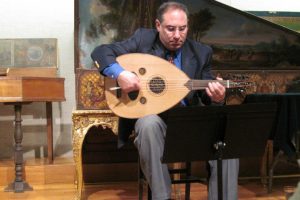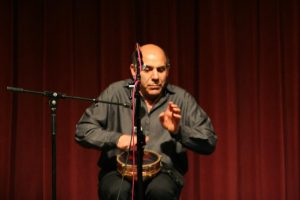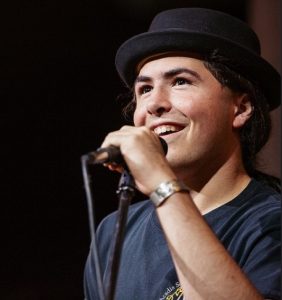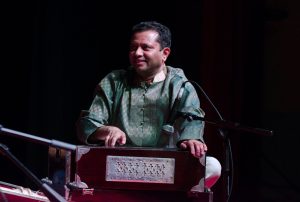environment India music Politics: 350.org benefit concert Cape Breton music climate change dumbeq fiddle Indian music Middle-Eastern music oud world music
by Warren
leave a comment
Meta
SiteMeter
Brighter Planet
Playing For The Planet: World Music Against Climate Change — June 2, 2018
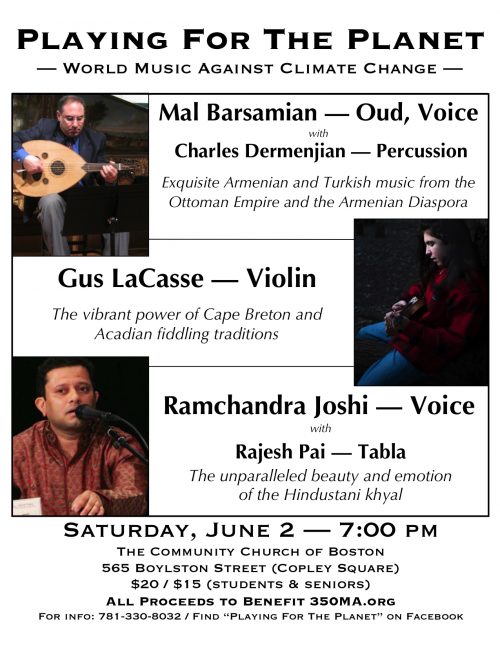
Mark your calendars for one of the year’s most exciting musical events!
On Saturday, June 2, the seventeenth “Playing For The Planet” benefit concert showcases master musicians from three different musical traditions, in a benefit for the environmental advocacy group 350MA.org.
Come and hear Mal Barsamian and Charles Dermenjian performing Armenian and Turkish music, Gus LaCasse’s Acadian & Cape Breton fiddling, and a Hindustani performance by vocalist Ramchandra Joshi.
The music begins at 7:00 pm, at The Community Church Of Boston, 565 Boylston Street (Copley Square), Boston.
Admission is $20; $15 students & seniors.
Tickets are available online through eventbrite.
For further information, please call 781-330-8032.
“Playing For The Planet: World Music Against Climate Change” is the seventeenth concert in an ongoing series of cross-cultural events produced by Boston-area musician and environmental activist Warren Senders. These concerts were conceived as a way for creative musicians to contribute to the urgent struggle against global warming. Their choice of beneficiary, 350MA.org, is focused on building global consensus on reduction of atmospheric CO2 levels — action which climatologists agree is necessary to avoid catastrophic outcomes.
Because the climate problem recognizes no national boundaries, the artists represent musical styles from three different parts of the globe, and share key musical values: listening, honesty, creativity, and respect. And, of course, they are all committed to raising awareness of the potentially devastating effects of global warming. It’ll be an incredible evening of powerful music — from some of the finest musicians in New England and the world.
About The Artists
Mal Barsamian and Charles Dermenjian
Mal Barsamian’s musical career began when he was four years old playing the doumbek (hand drum) with his father Leo Barsamian at an Armenian picnic. Mal comes from a family of oud players starting with his grandfather, great-uncle, his uncle and of course his father. He has gone on to become a sought-after oud player (lute) and clarinetist as well as other instruments such as doumbek, guitar, bouzouki, and saxophone in Armenian, Greek, and Middle Eastern communities for forty years throughout the country.
He performed with the late Esber Korporcu, an important figure in Boston’s Middle-Eastern music community, and has also appeared with Mehmet Sanlikol’s Dunya organization. Mal is a specialist in music written by Armenian composers active in Istanbul during the later years of the Ottoman Empire. Also trained as a classical guitarist, he obtained his Bachelor’s and Master’s degrees in classical guitar performance studying with Robert Paul Sullivan from the New England Conservatory of Music.
Mal is on the applied faculty staff at Tufts University’s World Music Department, teaching oud, saxophone, clarinet and percussion, an applied faculty member at Boston College and also leads the Middle Eastern Ensemble at New England Conservatory of Music.
Charles Dermenjian plays percussion, featuring the doumbek, the most commonly played percussive instrument throughout Middle Eastern cultures, and has performed extensively both across the United States and abroad. In addition to playing with numerous Middle Eastern musicians, Charles has performed locally with Stan Strickland, as well as several Berkley College faculty. Aside from performing, Charles has devised and applied specific rhythmic teachings as a form of meditative group therapy.
Gus LaCasse
“…a natural-born fiddle player…whose energy would power a small city.”
— Peter Sutherland, Young Tradition Vermont —
A folk fiddler with both speed and savage energy, Gus La Casse’s repertoire reflects his innovative spirit and dedication to the Cape Breton and Acadian fiddle traditions, playing both standards of the genre and his original material. Based in Downeast Maine, Gus maintains an active performance schedule as a solo artist and with other musicians including guitarist Peter Lindquist, rock-to-world-music band Big Tree and a contra dance trio.
Gus’ music has also taken him beyond Maine. He was the 2014 student in residence at The Acadia School of Traditional Music, appearing on the Canadian international television broadcast from the Congrès Mondial Acadien 2014. He traveled to Ireland as part of the Young Tradition Vermont touring group in 2016, and has enjoyed playing the legendary Club Passim in Cambridge, MA.
Ramchandra Joshi
An accomplished vocalist and harmonium player, Ramchandra Joshi was introduced to the world of music at the age of 8 by his mother Smt Anjani Tilak, a disciple of Pt Manikbua thakursdas. He has trained with Smt. Tulika Ghosh, a disciple of Pt Gyanprakash Ghosh from Kolkata, at Sangeet Mahabharati Music Academy in Mumbai.
Ramchandra Joshi’s Gayaki is inspired by the legendary vocalist from Gwalior Gharana Dr.Veena Sahasrabuddhe, with whom he performed on several occasions, notably the 1994 Malhar Festival at the Nehru Cente.
A specialist in khyal, thumri, natyasangeet, bhavgeet, bhajans and ghazals, he has toured extensively in India, USA, UK and Switzerland. Ramchandra holds B+ Grade from All India Radio.
As a harmonium accompanist Ramchandra has performed alongside many senior and junior artists like Arati Ankalikar-Tikekar, Konkana Banerjee, Sanhita Nandi,Girish Chatterjee, Sandeep Bhattacharya, Rahul Deshpande, Mahesh Kale, and many more. He has lived in the United States since 2003.
On June 2, Ramchandra Joshi will be accompanied by Sri Rajesh Pai on tabla.
About 350.org and 350MA.org
Co-founded by environmentalist and author Bill McKibben, 350.org is the hub of a worldwide network of over two hundred environmental organizations, all with a common target: persuading the world’s countries to unite in an effort to reduce global levels of atmospheric carbon dioxide to 350 parts per million or less. Climatologist Dr. James Hansen says, “If humanity wishes to preserve a planet similar to that on which civilization developed and to which life on Earth is adapted, paleoclimate evidence and ongoing climate change suggest that CO2 will need to be reduced from its current 400 ppm to at most 350 ppm.” (Dr. Hansen headed the NASA Institute for Space Studies in New York City, and is best known for his testimony on climate change to congressional committees in the 1980s that helped raise broad awareness of the global warming issue.) Activists involved in the 350 movement include Rajendra Pachauri (Chairman, Intergovernmental Panel on Climate Change), Vandana Shiva (world-renowned environmental leader and thinker), Archbishop Desmond Tutu (1984 winner of the Nobel Peace Prize and a global activist on issues pertaining to democracy, freedom and human rights), Van Jones, Bianca Jagger, Barbara Kingsolver and many more.
350MA.org is the Massachusetts Chapter of this worldwide advocacy group, and the hub for the Better Future Project.
====================================
The Community Church of Boston is a free community united for the study and practice of universal religion, seeking to apply ethical ideals to individual life and the democratic and cooperative principle to all forms of social and economic life. We invite you to read on to discover more about us, join us one Sunday for a thought-provoking and joyful time, or contact the church to find out more about our community: info@communitychurchofboston.org
====================================
Tickets are available online through eventbrite.
Education music Personal: genius near genius world music
by Warren
3 comments
Meta
SiteMeter
Brighter Planet
The Tony Schwartz Music Exchange Tape

In the mid-to-late 1970s, I lived in group houses with a broad assortment of interesting people. One of them was Seth Deitch, who had as part of his vast array of stuff an assortment of reel-to-reel tapes inherited from his father, the brilliant animator Gene Deitch.
Eventually we acquired a reel-to-reel machine and began the process of dubbing all these tapes onto cassette. They were in poor condition, so this amounted to a rescue operation.
Some of the material was old jazz, some of it was old radio commercials; one reel contained a set of 1949 performances by John Lee Hooker that many years later got released as “Jack Of Diamonds.”
And one reel held this extraordinary document:
Tony Schwartz, master of electronic media, created more than 20,000 radio and television spots for products, political candidates and non-profit public interest groups. Featured on programs by Bill Moyers, Phil Donahue and Sixty Minutes, among others, Schwartz has been described as a “media guru,” a “media genius” and a “media muscleman.” The tobacco industry even voluntarily stopped their advertising on radio and television after Schwartz’s produced the first anti-smoking ad to ever appear (children dressing in their parents’ clothing, in front of a mirror). The American Cancer Society credits this ad, and others that followed, with the tobacco industry’s decision to go off the air, rather than compete with Schwartz’s ad campaign.
Born in midtown Manhattan in 1923, a graduate of Peekskill High School (1941) and Pratt Institute (1944), Tony Schwartz had a unique philosophy of work: He only worked on projects that interested him, for whatever they could afford to pay.
{snip}
For many years he was a Visiting Electronic professor at Harvard University’s School of Public Health, teaching physicians how to use media to deal with public health problems. He also taught at New York University and Columbia and Emerson colleges. Because Schwartz was unable to travel distances, he delivered all out of town talks remotely. Schwartz was a frequent lecturer at universities and conferences, and gave presentations on six of the seven continents (not Antarctica). He was awarded honorary doctorates from John Jay, Emerson and Stonehill Colleges.
{snip}
“Documenting life in sound and pictures” is something Tony Schwartz begin in 1945, when he bought his first Webcor wire recorder and began to record the people and sounds around him. From this hobby developed one of the world’s largest and most diverse collections of voices, both prominent and unknown, street sounds and music, a collection that resulted in nineteen phonograph albums for Folkways and Columbia Records.
During the 1950s, Tony Schwartz sent this recording out into the world, presumably under an early version of a Creative Commons license.

While I was already getting interested in what was then called “Ethnic Music,” this recording was something completely different — dozens of different songs from all over the planet, each introduced by the same voice. I must have listened to the Tony Schwartz Exchange Tape a couple of hundred times over the next few years, but time marched on and the dubbed version of the Tony Tape came to rest in my collection alongside hundreds of other cassettes. In the early 2000s I duplicated it onto a CD, where it continued to lie dormant.
I bumped into Tony Schwartz’ name a few times on various Folkways lps, but never learned much about the man until I started listening to the Kitchen Sisters’ wonderful “Lost And Found Sound” series — and then I had a delightful shock of recognition. Give this audio portrait a listen.
Anyhow, I’ve been transferring all my sound files to my computer, and this one finally had its turn…and I says to myself, says I, “Well, this certainly deserves to be out in the world.”
Here you go, world.

